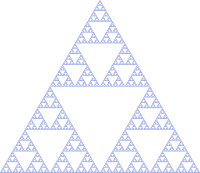- Monads are fractals
Monads are fractals
The intuition for FlatMap and Monad we built on day 5
via the tightrope walking example is that a monadic chaining >>=
can carry context from one operation to the next.
A single None in an intermediate value banishes the entire chain.
The context monad instances carry along is different.
The State datatype we saw on day 7 for example
automates the explicit passing of the state object with >>=.
This is a useful intuition of monads to have in comparison to Functor,
Apply, and Applicative, but it doesn’t tell the whole story.

Another intuition about monads (technically FlatMap) is
that they are fractals, like the above Sierpinski triangle.
Each part of a fractal is self-similar to the whole shape.
Take List for example. A List of Lists can be treated a flat List.
val xss = List(List(1), List(2, 3), List(4))
// xss: List[List[Int]] = List(List(1), List(2, 3), List(4))
xss.flatten
// res0: List[Int] = List(1, 2, 3, 4)
The flatten function embodies the crunching of the List data structure.
If we think in terms of the type signature, it would be F[F[A]] => F[A].
List forms a monad under ++
We can get a better idea of the flattening by reimplementing it using foldLeft:
xss.foldLeft(List(): List[Int]) { _ ++ _ }
// res1: List[Int] = List(1, 2, 3, 4)
We can say that List forms a monad under ++.
Option forms a monad under?
Now let try to figure out under what operation does Option form a monad:
val o1 = Some(None: Option[Int]): Option[Option[Int]]
// o1: Option[Option[Int]] = Some(value = None)
val o2 = Some(Some(1): Option[Int]): Option[Option[Int]]
// o2: Option[Option[Int]] = Some(value = Some(value = 1))
val o3 = None: Option[Option[Int]]
// o3: Option[Option[Int]] = None
And here’s the foldLeft:
o1.foldLeft(None: Option[Int]) { (_, _)._2 }
// res2: Option[Int] = None
o2.foldLeft(None: Option[Int]) { (_, _)._2 }
// res3: Option[Int] = Some(value = 1)
o3.foldLeft(None: Option[Int]) { (_, _)._2 }
// res4: Option[Int] = None
It seems like Option forms a monad under (_, _)._2.
State as a fractal
If we come back to the State datatype from the point of view of fractals,
it becomes clear that a State of State is also a State.
This property allows us to create mini-programs like pop and push,
and compose them into a larger State using for comprehension:
def stackManip: State[Stack, Int] = for {
_ <- push(3)
a <- pop
b <- pop
} yield(b)
We also saw similar composition with the Free monad.
In short, monadic values compose within the same monad instance.
Look out for fractals
When you want to find your own monad, keep a lookout for the fractal structure.
From there, see if you can implement the flatten function F[F[A]] => F[A].